GENIUS OF FRIENDSHIP: T. E. LAWRENCE
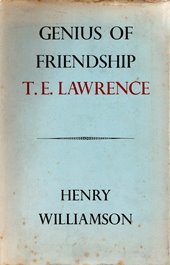 |
|
| First edition, Faber, 1941 | |
T. E. Lawrence by his friends, ed. Prof. A. W. Lawrence (Cape, 1937)
The Letters of T. E. Lawrence of Arabia, ed. David Garnett (Cape, 1938)
Men in Print: Essays in Literary Criticism, by T. E. Lawrence (The Golden Cockerel Press, 1940)
Lawrence of Arabia: A Biographical Enquiry, by Richard Aldington (Cape, 1955)
‘Threnos for T. E. Lawrence’, by Henry Williamson (in The European, 1954)
The Home Letters of T. E. Lawrence and his Brothers, ed. M. R. Lawrence (Blackwell, 1954)
T. E. Lawrence: Correspondence with Henry Williamson, ed. Peter Wilson (Castle Hill Press, 2000)
First published Faber & Faber, November 1941 (10s 6d)
(Matthews, Henry Williamson: A Bibliography, states 2000 copies printed.)
Faber & Faber, reprint, December 1941 (10s 6d)
The Henry Williamson Society, facsimile reprint limited to 500 copies, 1988 (£5.00) (currently available as an e-book)
This edition includes, as a frontispiece, a facsimile copy of the telegram sent by TEL to HW on 13 May 1935; while returning from the post office TEL's fateful motorcycle accident occurred, leading to his death six days later.
It is worth noting the unusual size of the two Faber editions: 10 x 6½ inches / 259 x 164 mm. With only 80 pages (of which 6 are blank and 4 are preliminary pages, so there are only 70 pages of actual text), it is tall and narrow. The pages are untrimmed, which more commonly would denote an expensive limited edition volume. When published it must have looked a striking book with its pristine light blue dust wrapper and classic Faber typographical design; sadly the wrapper has proved prone to fading and foxing over the years. A further quirk is the use of the paragraph symbol ¶ to denote paragraphs of extracts from TEL’s letters.
Genius of Friendship is HW's memoir recording the friendship and correspondence between himself and T. E. Lawrence: 'Lawrence of Arabia'.
HW is probably using the more unusual definition of 'genius' here: 'Tutelary (serving as a guardian) spirit of person, place; or institution for good; protective; person who powerfully influences person for good.'
T. E. Lawrence, 'Lawrence of Arabia' ('El Laurens' to the Arabs), was born in 1888, and became famous for his exploits in the Arabian desert in the First World War. Thereafter, having written his book Seven Pillars of Wisdom, he tried to bury himself in anonymity: in late 1922 he re-joined the forces using pseudonyms, first as John Hume Ross and then as T. E. Shaw (although he could not escape the continuous publicity – and indeed is considered by many to have invited it).
HW was drawn to the attention of TEL by Edward Garnett, the well-known literary critic, man of letters and publisher's reader for Cape, who had been active in establishing such writers as Joseph Conrad, D. H. Lawrence and E. M. Forster – and TEL himself – and who had encouraged and helped HW, being particularly supportive over the publication of Tarka the Otter, published in October 1927.
Around the time of publication of that book, Garnett posted a proof copy to TEL, then in the RAF and stationed at Karachi, India, as '338171 A/c T. E. Shaw’.
TEL replied to Garnett with a long letter dated 20 January 1928 of praise and criticism, stating that the book:
has kept me sizzling with joy for three weeks. The best thing I've met for ever so long.
Mainly the letter is a list giving page numbers from the book with points which he particularly liked or disliked. In some ways it is rather pretentious: for instance his adverse comment on the opening 'feminine' sentence, by which presumably he means 'passive'. The passage in question is an extraordinarily powerful evocation of twilight on a river and its meadow: to criticise it in that way is pedantic to say the least. TEL assumed Tarka was HW's first book and that he was encouraging a beginner: he did apologise in his next letter (direct to HW) when he discovered HW was already an established writer.
HW would have been aware of TEL from newspaper reports of his war exploits and publicity from time to time – and indeed does note later that he first heard of him in 1917 – but the first real notice that he took was when he read Revolt in the Desert (a highly abridged version of the massive Seven Pillars of Wisdom) when it was serialised in the Daily Telegraph. This was not, as HW states, in 1924, for it was serialised between 15 December 1926 and 10 January 1927.
HW immediately thought that they had affinity of thought (he noted a particular sentence by TEL as being very akin to one of his own in his manuscript of Tarka, then nearing completion), and felt he wanted to contact TEL, whom he was sure would be the soulmate friend he had always longed for; but he also felt that this would be presumptuous on his part and so did nothing.
So it was the realisation of all HW's hopes (both for his newly published book and for his admiration of TEL) when he received a registered envelope from Garnett in mid-February 1928, containing TEL's letter.
TEL’s complete letter was subsequently published in Men in Print: Essays in Literary Criticism, edited and Introduction by Prof. A. W. Lawrence (TEL's younger brother) in a limited edition of 500 copies (Golden Cockerel Press, 1940). It was reprinted in Threnos for T.E. Lawrence & Other Writings, ed. John Gregory (HWS, 1994; e-book, 2014).
So began a friendship, mainly conducted by correspondence (they met only twice, both times briefly) between these two most unusual highly strung and sensitive men: men (I think one can justifiably say) of twin psyches – a phrase used by HW himself.
With HW's immediate reply he enclosed a copy of The Old Stag, in which he wrote
Your stuff is Mt. Everest; mine Snowdon.
And in later books (The Gold Falcon, 1933, and Devon Holiday, 1935) he gives TEL the name 'G. B. Everest': 'G. B.' is probably a reference to George Bernard Shaw, with whom TEL was friendly (though more with Mrs Shaw), and whose surname he took for his own pseudonym.
Towards the end of 1928 TEL's presence near the Afghanistan border, where he had been posted to Miranshah, was discovered amid considerable rumour, and he was returned to England; after a month's leave in London he was posted to RAF Cattewater in Plymouth, South Devon, reasonably near HW in North Devon.
In due course a visit by TEL to HW at Vale House Georgeham (HW's then residence) was arranged. The first date, 30 June, was aborted due to heavy rain, but on 28 July 1929, despite further rain, TEL made the 3-hour journey on his Brough Superior motorcycle across Dartmoor, arriving about noon for a very simple luncheon with HW, his wife Loetitia and three-year-old Windles (Bill); baby John, 9 months old, is not mentioned and was obviously kept well out of the way!

HW uses this luncheon as his axis in Genius of Friendship, going back and forth, quoting comments from TEL's letters and also revealing much about his own self, his thoughts, and feelings.
The book opens (somewhat awkwardly) with a somewhat gossipy anecdote relating TEL's reaction to an invitation to dinner with a 'Society Hostess'. Although this serves as a vehicle to show TEL's reserved character, it is perhaps rather off-putting as an opening gambit. That HW himself realised this is shown by a note in his file copy that he made when preparing his later essay 'Threnos for T. E. Lawrence':
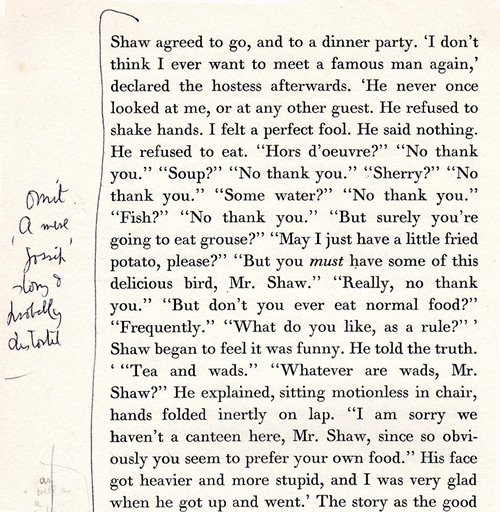
Once past that awkward opening (which perhaps reveals a nervous diffidence about starting so personal a book), HW gets into the rhythm of his subject. He relates several stories against himself of boasting in his early days about knowing famous people. These stories are almost certainly exaggerated, but the impression one gets today is that he possibly already understood that TEL was not above considerable exaggeration. Indeed TEL hinted at this over material contained in the Lowell-Thomas biography.
In one letter HW notes that he was going to the RAF display at Hendon and offers TEL a lift in his new car (a second-hand 6 horse-power Peugeot), and then to attend the presentation of the 1929 Hawthornden Prize to Siegfried Sassoon for his Memoirs of a Fox-Hunting Man. (HW had won this prize only the previous year.) TEL declined: too busy, and HW's car not fast enough to get him there and back in his allowed time off! (Sassoon himself did not – indeed, refused to – attend the ceremony: HW's diary has a few pages of notes that he hastily scribbled down during the various speeches.)
As explained earlier, after a hiccup due to weather, the day of TEL's visit eventually arrived and he appeared soon after the church clock struck noon.

The motorbike was of course one of his famous Brough Superior machines provided for his use by George Brough (though the Shaws paid for one of them). He used them hard and they were replaced at regular intervals! The journey across Dartmoor had taken three hours. He had to leave again at 1.30 p.m.: they only had 1½ hours together.
We read that they discussed All Quiet on the Western Front (Erich Maria Remarque's famous book) and their respective motorbikes: sadly HW's Norton had now been replaced by the Peugeot, as being more suitable for family travel.
HW relates that in 1919 when stationed at Folkestone he had made up a story that he had won a race on his Brooklands Road Special Norton, and that this was reported in the Evening News in June 1919. HW relates in 'Confessions of a Fake Merchant' (1930) that he had made this story up. But I am not convinced that this is so! The facts could be too easily checked and would not have gone unnoticed. HW often 'did himself down' in this way.
At one o'clock they had lunch: 'It was a happy meal.' Then TEL returned to Plymouth and his work on the Schneider Trophy Committee. Soon afterwards, at the end of 1929, HW and family moved a few miles east and inland to live at Shallowford on the River Bray (near South Molton).
When HW's The Patriot's Progress was published TEL again sent a letter of encouragement, praise and criticism. He liked the book:
It is all right . . . your writing scope grows on me. This book is a tapestry . . . It is the most complete two-dimensional thing possible.
TEL was at that time translating Homer's Odyssey, and he sent HW a small selection of page proofs most beautifully printed; he states that he had bought the 'Dorset Cottage' out of its profits. (These pages were sold by the Literary Estate with the TEL letters in July 2005.)
In the autumn of 1930 HW was invited to visit America by his publisher John Macrae – not exactly, as HW relates here, a visit 'on impulse'. HW briefly mentions his fishing trip to Mastigouche which took place first, then moving on to New York, where HW first revised The Dream of Fair Women for a new edition. (Joined by his wife in January, HW went on to deliver his 'Hamlet' lecture at Dartford College, Yale and Harvard.) TEL’s letters were always supportive.
Out of this trip to the USA arose HW's novel The Gold Falcon, published anonymously amid a considerable furore: chief contenders suggested for the authorship were Robert Graves and TEL! HW sent TEL (who features as G. B. Everest) a copy of the special vellum edition of which he had 9 copies printed with special dedications. TEL's read:
|
To 'T. E. Lawrence' by whose taken thought the author added a cubit to his stature. |
TEL wrote back:
I've been grinning through the week-end over the Falcon . . .
and continued:
The Falcon has that jumpy, nervous, stippled technique . . . it fits a jazzy subject, and conveys an astonishing sense of movement, all through the tale.
HW continues in Genius of Friendship to compare, or rather to show a connection between, T. E. Lawrence and D. H. Lawrence.
In early 1934 HW was sent an invitation to visit Georgia in the American South by the rich society hostess and arts patron Mrs Louise Reese. TEL was then stationed at Southampton working on speedboats (these were the prototypes for the RAF’s rescue launches in the Second World War). HW was to sail from Southampton on the SS Berengaria on 28 February, and he wrote to inform TEL, adding:
I wonder if you'll be about in a speedboat?
HW was at that time much involved with the book that his friend from schooldays, Victor Yeates, now terminally ill with TB, was writing (Winged Victory, 1934), and he asked for TEL's help in promoting it. TEL wrote back; he was a little reticent about helping the book but hoped to come and see HW off to the USA. Which he did: and this second meeting is described here in Genius of Friendship (and also in Devon Holiday, which contained, inserted at the front, a 'Postscript' explaining that the character 'G. B. Everest' had since died, so totally giving away the identity of this character, although it was pretty obvious in any case).
HW gives here his thoughts on TEL's character: interesting, but very typically HW, with references and comparison to the character of Jesus.
Also there to see HW off was his friend John Heygate, then in England (he worked for the UFA film studios in Berlin) recovering from an intestinal operation. Their friendly conversation was interrupted by the Cunard Publicity Officer, who having recognised the famous man, asked for a photograph. TEL explained that this was not allowed, clammed up, said goodbye, and disappeared.
While in Georgia (including a trip to Florida), HW wrote The Sun in the Sands, the semi-autobiographical, but progressively fictional, work that was not actually published until 1945. Meanwhile Yeates finished work on Winged Victory. TEL read a proof copy and found it 'admirable, admirable, admirable'. While in Georgia HW sent him a bag of pecan nuts:
I eat one a week, ritually, as I visit my cottage [Cloud's Hill, near Bovington, Dorset] where they are stored.
On his return HW issued a further invitation, but TEL was very busy with work and with his renovations at Cloud's Hill, as he wrote ready for:
March next, exit of T.E.S. from the Air Force.
There follow several extracts from an interesting letter dated 11 December 1934 from Bridlington, York, his current RAF posting, where TEL seems more relaxed than usual. Victor Yeates died a few days after this. HW informed TEL, who commiserated and again praised Winged Victory. He wrote again to thank HW for a copy of his 'Tribute' printed in John O'London's Weekly in January 1935. (This was included in the second impression of Winged Victory, published in November 1934, five months after the first edtion.) At the end of that letter TEL added:
One month to go! Only a month. I can feel it happening now.
TEL left the RAF on 25 February 1935. HW writes here: ‘T. E. Shaw was discharged finally from the R.A.F., and went to live at his cottage on Egdon Heath.’ Note the clever (and charming) use here of Thomas Hardy's fictional name for the area. TEL had known the writer well and sadly had been posted to India just before Hardy died. HW had met Hardy briefly, just before the great writer died (his visit to Max Gate is recorded in the Day Book there), and he praised Tarka the Otter.
It was not of course as simple for TEL as that: he felt empty and disorientated – and was hounded by the press, until he complained to the authorities. HW writes here a very discerning passage about TEL's situation and contrasting it with his own. Interestingly he mentions to the effects of the Versailles Treaty.
HW was by then working on a manuscript left by Victor Yeates called 'Family Life', editing and rewriting, and turning it into a dramatic play. He was due to visit London on Tuesday, 14 May 1935 to see his publishers and others. He wrote to TEL asking if he could call in to see him at Cloud's Hill.
Here in Genius of Friendship HW writes that this letter concerned a proposal that Lawrence should address a meeting of 'ex-Service men in the Albert Hall' to help regenerate Europe. This is a total tarradiddle and arose out of HW's subsequent ideas. The content of that letter actually concerns the Yeates manuscript that HW wanted TEL to read and comment on. (The text of the letter was printed in my article 'The Genius of Friendship, Part I: T. E. Lawrence', HWSJ 27, March 1993. It is also found in T. E. Lawrence: Correspondence with Henry Williamson, details given below.)
TEL did not receive this letter until Monday, 13 May, the day before HW's proposed visit, and knowing that a letter would not reach in time, he hurried to the nearby Bovington Camp post office to send a telegram:
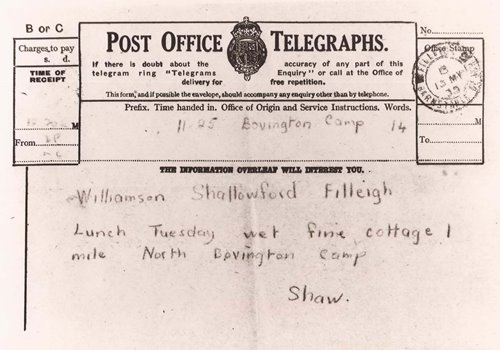
Returning to Cloud's Hill on his Brough Superior TEL was involved in the accident which led to his death six days later. HW heard the news over the wireless.
On Saturday, 18 May HW made the journey he had proposed, stopping off at the military hospital at Bovington Camp where he saw:
with a slight shock, faces known before only in Seven Pillars of Wisdom.
He was assured that TEL would recover and, feeling he should not intrude further, continued his journey, not to London, but to stay with John Heygate at his father's house near Lymington on the Hampshire coast.
During that night a crisis occurred in the patient's condition and T. E. Lawrence – Lawrence of Arabia – died in the early hours of the following morning, 19 May 1935. HW ends Genius of Friendship with these words:
So he died; and is immortal with the shining of the sun upon plain men, his equals.
Shallowford 1936
The word 'Shallowford’ is misprinted as 'Shallonford': the error must have infuriated HW, though in his own copy he merely corrected it. The attribution had not appeared on the proofs that HW received, so he would not have known about the mistake until he received a finished copy of the book. It remained uncorrected in Faber’s reprint, and deliberately so in the 1988 facsimile edition published by the HWS.
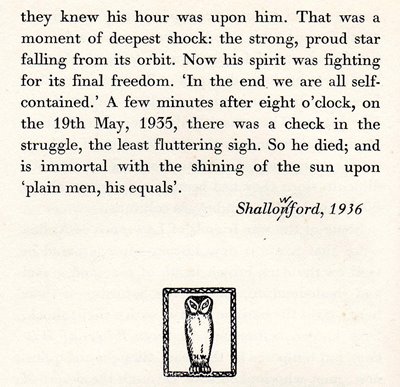
Within the essay, he notes he is writing it:
in my hill-top hut overlooking the Atlantic, in this sunny weather of July 1936.
I will come back to this at its correct chronological point. I think it is useful to state here that while there have been many books (some learned – some spurious) examining the life and deeds of T. E. Lawrence, Genius of Friendship gives an intimate portrait of the man that is unsurpassed elsewhere.
*************************
HW had now suffered in quick succession the blow of the death of two close friends, Victor Yeates and T. E. Lawrence. His diary is more or less blank for the rest of that year, apart from a very few business details. One such note is on Thursday, 13 June 1935: 'Lawrence article posted to Atlantic Monthly.' However no article of this nature was ever published. TEL's younger brother, Professor A. W. ('Will') Lawrence, executor of his Estate, put an embargo on the use of any TEL material until such time as he granted permission. It is quite possible that HW’s article forms the basis of the subsequent Genius of Friendship.
Apart from the death of TEL causing him personal distress, HW had an immediate problem to solve. He had featured TEL as 'G. B. Everest' in quite jocular scenes in his forthcoming Devon Holiday, already at the printers, and which had already had its own share of drama (see my consideration of this book). He now hastily prepared a 'Postscript'. The book was published on 24 June 1935, and contains the Postscript in its own 4-page collation added to the front of the book where, although not its intention, it acts in effect as a dedication.
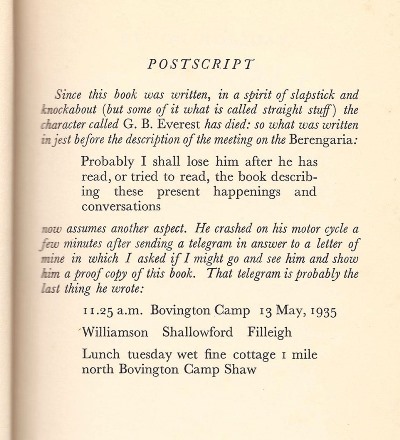
HW was also totally immersed in the urgent and very difficult writing of Salar the Salmon, to the point of absolute exhaustion. Published in October 1935 it is dedicated to the two friends who had so recently and tragically died:
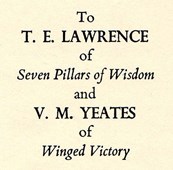
Just as Salar was finished at the beginning of August 1935, HW received an invitation from John Heygate to visit him in Germany. He left at the beginning of September for about three weeks’ much needed holiday. This visit reinforced the viewpoint he had taken since meeting John Heygate at the end of 1928. He was extremely impressed by all that he saw and heard, for the official guide assigned to him made sure that he saw only the positives of the 'new Germany'. It is also evident, when one assimilates various clues in his archive material and writings, that on his return he did realise that there was a very real threat of another war looming. This explains his highly agitated state of mind which led to his visit to his friend (and publisher) Richard de la Mare over the New Year of 1936 at their home in North Norfolk, and which led in turn to the purchase of Old Hall Farm, Stiffkey: the 'Norfolk Farm'.
Then in April 1936 there was a report that HW's last letter to TEL had contained the suggestion that TEL would attend the series of meetings to promulgate World Peace, and that his reply by telegram signified his support for this idea. This was of course totally untrue. But it is clear that HW now thought that TEL, with his experience and fame, would indeed have been the one person who would be able to talk to Hitler and persuade him not to go to war – and so for him it became a fact. Once stated, he believed his own fiction.
*************************
On 4 June 1936 HW's diary records (again – there are very few entries) further information concerning articles he had written:
Evening Standard to go
TEL article to go
John O'London to go
All too cryptic, and there is no further information. But possibly the 'TEL article' was HW's contribution to:
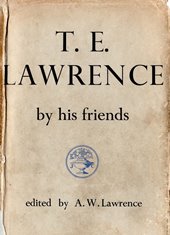 |
T. E. Lawrence by his friends
Edited by Professor A. W. Lawrence
Cape 1937
It is interesting to note that A. W. Lawrence did not intend to publish an official biography. This volume is in its place. Perhaps this was because that would have meant revealing facts that the family wanted to keep hidden: Mrs Lawrence was still alive. Professor Lawrence's own very interesting essay does hint at things hidden.
In his contribution (pp. 451-55), HW gives in the opening paragraph the sentence from TEL that was so like his own from Tarka the Otter:
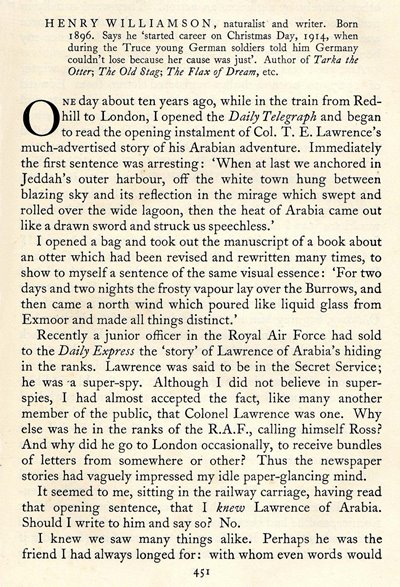
He relates how TEL had sent the criticism of Tarka, and a brief description of the 1929 meeting:
Our lunch, with Loetitia and our small son Windles, was the best meal I had ever eaten. . . . I thought much about him in the time that followed. His letters made me sad. . . .. He wanted to be [plumb ordinary]; he wanted to be happy; but he wasn't plumb ordinary; so he wasn't happy.
HW states that TEL was exhausted and despondent due to semi-starvation.
To me he was and is the personification of honour . . .
And HW brings in here his often repeated idea of the connection between 'clarity' and 'charity'.
He then reiterates his idea that Lawrence was the man to lead England in a peace movement and to meet Hitler with this in mind: that he had written to him thus and so the telegram of response that led to the fatal accident.
*************************
We have now come to the point that gives the date for the writing of Genius of Friendship, stated by HW within the book as being 'July 1936'. There are no diary entries to verify this. During 1936, having bought the Norfolk Farm, HW was busy making preparations to become a farmer and was writing Goodbye West Country (1937), which also contains references to TEL. As stated, Genius of Friendship contains a large number of direct quotations from TEL's letters, and Prof. A. W. Lawrence vetoed any use of letters at that time. So the essay could not be published at this time in any case. It would seem that HW deposited it with Richard de la Mare at Faber for safety (indeed, it may have been lodged with the firm ready for publishing!), as he also did with his manuscript of The Sun in the Sands.
*************************
In 1938 a collection of TEL's letters did appear:
 |
The Letters of T. E. Lawrence of Arabia
Edited by David Garnett
Cape, 1938
David Garnett (1892‒1981) was the son of Edward Garnett (1868‒1937), the critic and writer who had been the catalyst for so many famous writers. David Garnett had been a conscientious objector during the First World War and worked on a farm. He came into prominence with his first book Lady into Fox (1922). As the son of a man who had helped him, in his turn TEL gave the young Garnett a great deal of encouragement. The work of editing these TEL letters, of which in the first edition there are 583, into a book was surely a tour de force.
This first edition contains four letters from TEL to HW, mentioning The Dream of Fair Women, The Gold Falcon, The Linhay on the Downs, The Old Stag and Tarka the Otter, together with the final telegram.
It also contained a note about D. H. Lawrence which David Garnett included as being from TEL to HW – and which Garnett, in an earlier entry, notes as the best analysis of Lady Chatterley's Lover that he had ever seen. It was in fact a note written by HW himself (their handwriting was very similar), and which he subsequently stated had been included in his bundle of letters by mistake. When the error was discovered David Garnett was furious, and although HW explained and apologised, it caused a falling out between himself and Garnett. (The original note is reproduced in my article 'The Genius of Friendship, Part II: Richard Aldington' (HWSJ 28, September 1993). 'William Hickey' in the Daily Express, 13 December 1938, spilled the beans! (‘William Hickey’, a society gossip column, served as a pseudonym for various writers over the years; at this time it was the journalist and politician Tom Driberg.)
In HW's own copy of Letters he stuck this cutting, writing a pencilled note . . .
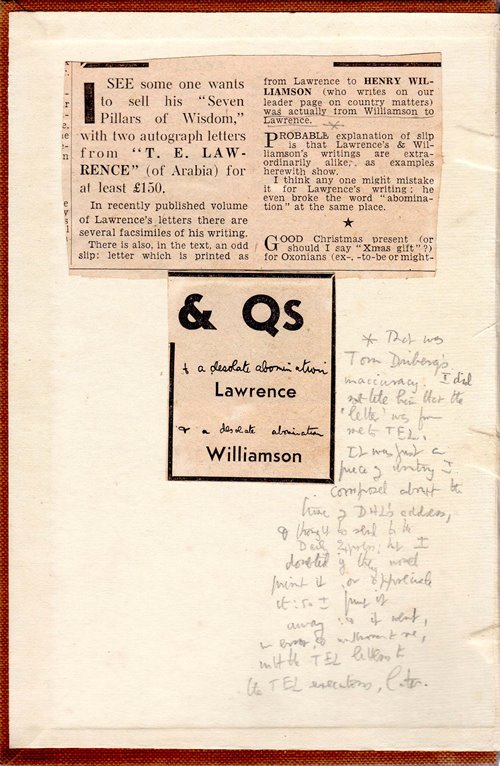
. . . while in his file copy of Genius of Friendship he pasted the cutting supplied by Durrant's Press Cuttings agency (mis-spelling Driberg's name):
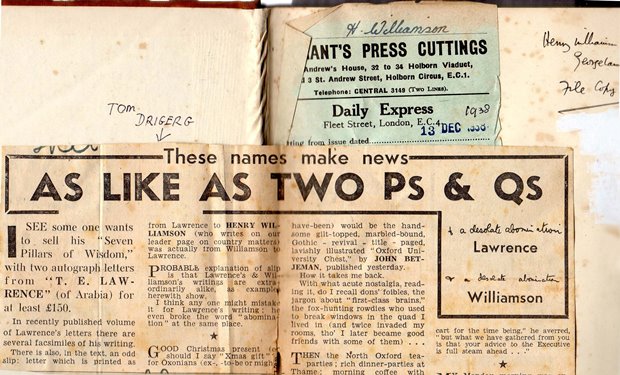
In a greatly abridged edition of the book – 245 letters only – by World Books in 1941, only one item to HW is included: the final telegram. One feels Garnett would have liked to delete HW altogether; but of course that telegram could not be ignored.
*************************
The next official publication was:
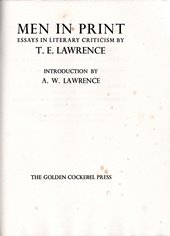 |
|
| Title page |
Men in Print: Essays in Literary Criticism by T. E. Lawrence
Introduction by A. W. Lawrence
The Golden Cockerel Press, 1940
The Bibliographical note at the end of the copy in the Literary Archive states:
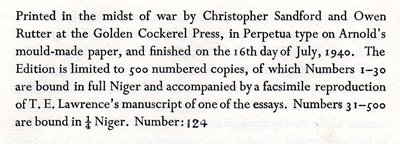
This book contains TEL's letter of criticism of Tarka the Otter, and on the title page for this HW has written:

*************************
Then, in the summer of 1941, HW received the permission he had been waiting for, noting in his diary on
Tuesday, 17 June:
Messrs Tample, Joseph, Ponsonby & Co., solicitors,
gave permission for the T.E.L. essay, subject to 4 conditions.
Letter sent to Fabers, via R de la M today.
There is nothing within his archive to indicate whether the permission was unsolicited or HW had previously sent a request reminder to Prof. Lawrence. I suspect the latter is more likely.
The contract with Faber was signed on 20 August 1941, but HW did not record this in his diary. He had just returned from the three-week wood-cutting visit to Devon (see In the Woods), to rain and possible ruination of the harvest – and to find valuable haystacks not properly covered in his absence. The entries here only concern those farming matters.
The contract shows that HW's royalties were set at 20% of the published price of 10s 6d, with an advance of £100 on publication. (On 2000 copies therefore the total royalty would have been just over £200 – but the book was immediately reprinted, which of course would have increased that total amount.)
Genius of Friendship appeared at the end of November 1941. There is no mention of this in his diary, but HW did mark that he received the advance on 5 December:
. . . Feeling very ill.
£100 from Faber for T. E. Lawrence essay.
Some years later he inserted this note in his own copy:

*************************
There are no reviews within HW's archive; it must have sold well, as it was reprinted within a month of publication, so surely there were some?
*************************
A year later he noted in his diary on 4 August 1942 that he had visited TEL's grave at Moreton Church on his way back to the farm after two and a half weeks’ holiday in his field at Ox's Cross with Ann Thomas. At the grave he met two girls, whom he took out to tea at the 'Tess of the Durbeyfields' farm!
*************************
The long-awaited publication of Genius of Friendship was not the end of the matter for HW. In the mid-1950s everything to do with TEL was stirred up amid considerable controversy when Richard Aldington published his biography of TEL.
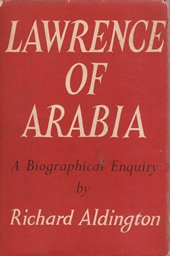 |
Lawrence of Arabia: A Biographical Enquiry
Amiot-Dumont, Paris, 1954
Collins, 1955
Richard Aldington (1892–1962), a man of tempestuous and forthrightly honest nature, had become known at an early age when, just before the First World War, he was one of those involved in the Imagist movement together with Ezra Pound and Wyndham Lewis. Aldington served in the war, and was gassed and suffered from shell-shock.
Aldington and HW first made contact when Aldington wrote to HW praising The Wet Flanders Plain, published in 1929, followed soon after by his own acclaimed 'anti-war' novel Death of a Hero (1929). But the two men were really brought together by the young Australian poet Alister Kershaw, when in 1947 he travelled to Europe hoping to particularly meet three writers he particularly admired: the poet Roy Campbell, Richard Aldington (these two now living in France), and Henry Williamson, which he did in that order. Kershaw in effect became Aldington's amanuensis, and began to work hard on his behalf soon after their first meeting.
HW was then editing The Adelphi, and at Kershaw's suggestion he wrote asking Aldington for a contribution. Kershaw also urged a meeting between the two, and so HW spent his second honeymoon with new wife (Christine Duffield, whom he married on 13 April 1949) at Aldington's home Le Lavandou at Var on the south coast of France. The two men got on well and a firm friendship developed – although, by necessity, again mainly by correspondence.
Aldington, who had several biographies published (his Duke of Wellington won the James Tait Black Memorial Prize in 1946; another of D.H. Lawrence was considered controversial), was already contemplating a biography of T. E. Lawrence, seemingly prompted by Kershaw, who by then knew about HW's friendship and who himself was an avid admirer of the great Lawrence of Arabia.
Aldington very quickly found there was a big problem, as his letters to HW in due course show: at a very early stage he discovered there was a mystery surrounding TEL's parentage which he could not fathom. Today the story is well known, but at that time the evidence was very well hidden and no-one concerned was prepared to reveal the truth. (One can now see how and why Prof. A. W. Lawrence had been so circumspect in all his own dealings with TEL's affairs.)
A letter to HW, dated 4 January 1951, reveals Aldington's dilemma:
The TEL is the hardest book I have ever attempted, and I despair of success. Practically everything he professed at one time he denied at another; he gives contradictory accounts of the same event or motives; his friends contradict him and each other. There is some mystery about his family, a skeleton somewhere. I am trying to discover it. . . . The disentangling is heart-breaking. . . .
Aldington asked HW to try and check various facts, including TEL's entry in Who's Who, which showed that TEL himself was involved in a cover-up. Basically it emerged that TEL had been born out of wedlock. However, Aldington was also discovering what appeared to be a large number of other discrepancies in TEL's known life story. This eventually made him distrust everything to do with his subject. It is evident from his letters to HW that he was horrified by the mare's nest he was uncovering. He had set out to write the biography in good faith and now faced a serious dilemma. His own integrity would only allow him to tell the truth: but it was obvious too that this truth would be denied by those close to TEL (Aldington called them 'The Lawrence Bureau'). He was blocked at every move.
*************************
HW of course was becoming increasingly agitated by this state of affairs. He understood Aldington's problem to a large extent, but his real loyalty lay with TEL. As the deadline for publication of the book came closer he decided to pre-empt – or try to mitigate – its effect by writing a long article:
This was published in The European in two parts: Part I, May 1954 (No. 15); Part II, June 1954 (No. 16)
(Both parts are reprinted in Threnos for T. E. Lawrence and Other Writings, ed. John Gregory, HWS, 1994; e-book, 2014.)
HW's proof copy of Genius of Friendship has the first 3 pages (pp. 9–11) lightly crossed through with a note showing a new beginning at the top of page 12. This was his preparation for ‘Threnos’.

Several further pages are also lightly crossed through, and there is a scattering of pencilled revisions in the margins. A final note shows these revisions to have been made in 1954: that is, for the ‘Threnos’ essay. (Further, HW pasted on to the blank end pages of this proof copy his 'Tribute to V. M. Yeates' from John O'London's Weekly, January 1935.)
HW opens this essay by quoting the 'THRENOS' from Shakespeare's poem ‘The Phoenix and the Turtle’. (Discussion about this can be found in my Editorial, HWSJ 28, September 1993.) He then relates how he met Alister Kershaw and in due course Richard Aldington, and the latter's increasing perplexity as he prepared his biography of TEL. HW tries to be fair to Aldington while maintaining his position towards TEL.

He then launches into the tale of how his father turned him out (an apocryphal story, this), his early life in Devon and the writing of Tarka the Otter. That leads him on to the ‘Tarka’ letter written by TEL. He gives his own analysis of TEL's behaviour: his reasoning why TEL told lies – that he himself told lies out of nervousness.
The text now mainly becomes more or less the material from Genius of Friendship. Then, towards the end, HW returns to his purpose – the forthcoming Aldington biography. He reiterates that he has seen neither a proof copy nor a copy of the work.
But I do know some of the contradictions which have, apparently, been checked and cross checked by the biographer.
And then rather subtly gives the game away:
My very dear ‘T.E.’, . . . you who were and are . . . a veritable son of love . . .
Dear Lawrence of Arabia, ‘world's imp’ as the imaginative Arabs called you (and they knew!) did your imagination fizz over at times?
And so, in effect, HW is admitting here that TEL may have embroidered the truth, out of fear of discovery. HW ends:
Let the critic who has never slurred or twisted in his own life throw the first stone.
Manuscripts and corrected typescript versions of both A Genius of Friendship and ‘Threnos for T. E. Lawrence’ are part of the HW collection held at Exeter University.
*************************
Aldington was upset by HW's attitude (understandably so: he was exhausted and exasperated beyond all measure by the fall-out engendered by his book), and the two men had a serious falling out over this matter. Nevertheless, he sent an inscribed copy of his book to HW, and after a while, to the credit mainly of Aldington, their friendship resumed where it had left off.

For further background to this story see:
AW, 'The Genius of Friendship – Part I: T. E. Lawrence (HWSJ 27, March 1993)
AW, 'The Genius of Friendship – Part II: Richard Aldington (HWSJ 28, September 1993)
HWSJ 28 also includes HW's tribute to Richard Aldington: 'Dear Friend of Lavandou', printed originally in Richard Aldington: An Intimate Portrait, ed. Alister Kershaw (Southern Illinois University Press, 1965), which was based on HW's 'A Visit to Richard Aldington', published in The Aylesford Review (Autumn 1963) and a similar article in 'Words on the West Wind', The Adelphi (Autumn Book Number 1949). A few pages of typescript still currently in HW's personal archive are seemingly an early version of his Aldington tribute, though the ending is missing. They are appended in the Postscript.
*************************
Also in 1954 there appeared, perhaps also to forestall the Aldington biography storm, a very solid (nearly 750 pages) and prestigious volume:
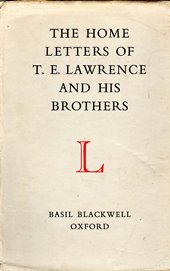 |
The Home Letters of T. E. Lawrence and his Brothers
With an 'Allocation' by Winston Churchill as Introduction
Edited by M. R. Lawrence (TEL's oldest brother, Montague Robert)
Blackwell, 1954
Churchill's 'Allocation' had been given at an unveiling of a memorial at TEL's school in 1936. (An 'allocation' is a formal hortatory address – usually by the Pope, but tends to be liturgical; and historically was a duty performed gratuitously by a rich Athenian: Mark Anthony's speech 'I come to bury Caesar' comes to mind!)
In his accompanying 1954 letter (reproduced in facsimile) Churchill, writing as Prime Minister from 10 Downing Street, states that despite the intervening years he finds not one word to alter in his peroration:
It is the measure of his greatness that his multiple achievement has passed beyond opinion into history.
The letters within the volume are from the three dead Lawrence brothers only: Frank Helier (born 1893), killed in action 9 May 1915; William George ('Will', born 1889), an observer in the RFC, shot down soon after arrival in France, 23 October 1915; and TEL ('Ned'), whose letters make up the major portion of the book.
It is noticeable that there is no mention of parentage in the short biographical paragraphs in this volume. (However, there was never any attempt either to answer or justify Aldington's findings and criticisms.)
HW wrote two reviews of the book, first for John O'London's Weekly (2 July 1954); and then for The European (Vol. IV, No. 21, November 1954).
In the first he wrote that the book is
as it were a private monument . . . of three brothers, all athletes, all scholars of Oxford University, all clean-living virtuous young men who were of a generation which perished in Europe.
It is of course TEL's letters that HW is most interested in, and he notes that he was killed:
on a ten horse-power, top-heavy motor-cycle, throwing himself off the road . . . to avoid hitting two boys on bicycles.
In both reviews he notes that TEL was starved, grossly underweight and had no resistance. But:
all the letters, and the spirit of the three brothers, seem to be a unity, which will remain long in the minds of scholars and poets.
The review ends with reference to Churchill's 'Allocation', where Churchill echoes his own famous phrase 'We will fight . . .’, stating that TEL's name:
will live in English letters; it will live in the traditions of the Royal Air Force; it will live in the annals of war and in the legends of Arabia.
HW's review in The European reads more fluently. Interestingly he compares the three Lawrence brothers to the three Bradford brothers – one of whom was the famous 'Boy General' that HW writes about in the First World War volumes of his own Chronicle of Ancient Sunlight. In 1954, when writing this review, HW was in the middle of writing about that war period.
In this review he retracts his suggestion made in ‘Threnos’ that TEL may have made things up: for since the publication of Aldington's book he has been 'shown papers and letters which dispel all doubts. He was entirely truthful and the records will eventually prove it.’ (Nevertheless, he then does refer to some small discrepancies.)
(The background to this statement is that HW had been approached by Eric Kennington – TEL's friend and the artist who had made the striking pastel portraits for Seven Pillars of Wisdom and sculpted the memorial bust and full recumbent figure of TEL – on behalf of Mrs Lawrence, and he had had a meeting with them and been shown some papers. However, other letters from Kennington show that he had his own ambivalent thoughts about TEL: a most interesting side-issue to this total episode.)
In both reviews HW notes TEL's annoyance with his mother: 'a woman of great power of will'. He is of course reflecting here too his annoyances with his own mother. He ends:
The three writers of this book reveal themselves to be very good men.
HW veered between his two loyalties but he didn't so much sit on the fence as jump off it, first on one side, then on the other. But his devotion to TEL was his uppermost concern. TEL was his hero, and he couldn't allow him to be seen as a charlatan.
Both these reviews were reprinted in the following volume.
*************************
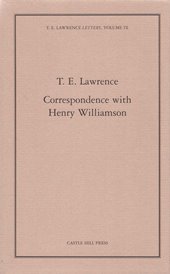 |
T. E. Lawrence: Correspondence with Henry Williamson
(T. E. Lawrence Letters, Vol. IX)
Edited by Peter Wilson, with Prologue and Epilogue by Anne Williamson
Foreword by Jeremy Wilson
Castle Hill Press, 2000 (limited edition of 700 copies)
(Castle Hill Press is owned by Jeremy and Nicole Wilson. Peter Wilson is their son.)
Originally intended to be published by the Whittington Press, which regretfully had to give up the project due to the costs involved in a limited edition of such prestigious note, this volume contains the complete correspondence between these two men, with notes and biographical comment by Peter Wilson and Anne Williamson. The dust wrapper blurb sums up their friendship thus:
Despite these reservations [about HW's extra-marital affaires] there really was an unusual quality in their relationship. Williamson is revealed as a skilful and extremely observant writer, but nevertheless a man who was introspective, egocentric, insecure, and intensely lonely. Exactly the same words could be used to describe Lawrence, and the similarity that Williamson sensed was real.
*************************
With this total record of the letters between TEL and HW now in the public domain following the publication of the above book, TEL's letters to HW were sold by the Literary Estate at Sotheby's on 12 July 2005. Other items included in the sale were HW's copy of Seven Pillars of Wisdom, the pages from the Odyssey given by TEL to HW, and also the letters from Richard Aldington to HW.
*************************
The dust wrapper for the first edition, Faber, 1941; when published it must have looked a striking book with its pristine light blue dust wrapper and classic Faber typographical design; sadly the wrapper has proved prone to fading and foxing over the years:


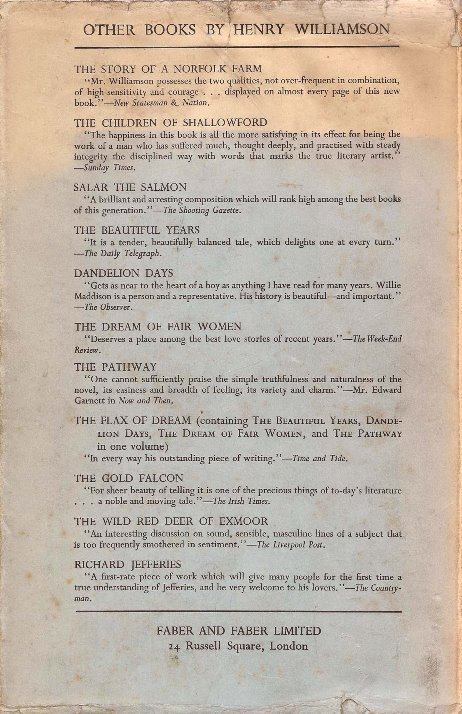
The Henry Williamson Society issued a facsimile reprint in 1988 (but reducing the size) to celebrate the centenary of Lawrence's birth, with a plain card cover:

